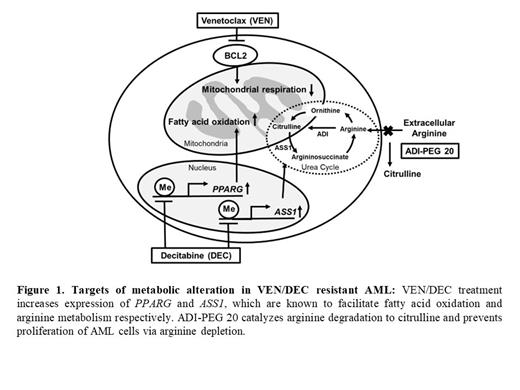The combination of venetoclax (VEN), an inhibitor of the anti-apoptotic factor BCL2, with the hypomethylating agent (HMA) decitabine (DEC) is the current frontline standard therapy for elderly patients with acute myeloid leukemia (AML). Despite the success of VEN/HMAs in inducing remission in AML, significant proportion of patients remain refractory to the combination therapy and others relapse after initial response.
To elucidate underlying mechanisms of resistance, we performed transcriptomic and DNA methylation analyses on VEN/DEC pre- and post-treatment samples from AML patients participating in a prospective clinical trial of DEC10-VEN (NCT03404193). We have previously reported that AML cells from non-responders demonstrate significant upregulation of mRNA expression of the fatty acid metabolism activator PPARG ( Peroxisome Proliferator-Activated Receptor γ) and ASS1 ( Argininosuccinate Synthase coding rate-limiting enzyme in the arginine biosynthesis) after VEN/DEC treatment, both accompanied by their transcription start site demethylation ( Yamatani et al. ASH 2022).
In this study, we performed single cell (sc) ATAC-seq to profile the accessible chromatin changes that are associated with VEN/DEC resistance. BM samples from one patient who achieved complete remission with incomplete count recovery and later relapsed (pre- and post- VEN/DEC treatment) and 2 healthy control bone marrow cells were utilized. A total of 23,803 cells were sequenced, read alignment and initial stages of data processing were performed using Cell Ranger (version 7.0.1; 10x Genomics), then cells were clustered by Uniform Manifold Approximation and Projection (UMAP) and annotated using the Azimuth application, which distinguished leukemia-associated clusters. In the leukemia-associated cell cluster, PPARG motifs in accessible chromatin were significantly enriched compared to other clusters. After VEN/DEC treatment, further increase in the relative abundance of PPARG motifs along with chromatin accessibility of CXCR4 and CDC42EP4 genes, which have RRARG accessible motifs, was observed.
Next, the role and mechanism of PPARG in the resistance to VEN/DEC was investigated using four AML cell lines with different sensitivity to DEC. PPARG expression was increased after DEC treatment in the less sensitive cells (HL-60 and MV4-11) but was unchanged in the more sensitive cells (OCI-AML3 and THP-1). To confirm that PPARG upregulation is associated with VEN/DEC resistance, we generated PPARG overexpressing HL-60 and MV4-11 cells using a lentiviral system. In the PPARG-overexpressing (OE) cells, VEN/DEC-induced cell growth inhibition and apoptosis were significantly reduced compared to the mock-transfected cells (PPARG -OE vs mock; cell growth inhibition: HL-60, 30% vs. 54%; MV4-11, 33% vs. 56%; apoptosis induction: HL-60, 14% vs. 38%, MV4-11, 25% vs. 36%; p < 0.05). To determine whether the suppression of energy metabolism by VEN/DEC is inhibited by PPARG overexpression, we performed an extracellular flux assay using PPARG-OE cells and mock HL60 cells. The results showed that VEN/DEC treatment reduced reserve respiratory capacity by 32% in mock cells, while VEN/DEC therapy was associated with an increase of 37% in PPARG-OE cells (p < 0.05).
ASS1 is another potential target associated with metabolic alterations in VEN/DEC-resistant AML. We next investigated the effects of arginine deprivation by combining the arginine-degrading enzyme pegylated arginine deiminase (ADI-PEG 20) with VEN/DEC. We used HL-60 cells with low baseline ASS1 expression, which was increased by DEC treatment, and MV4-11 cells with high ASS1 expression, which was not altered by DEC. HL-60 was more sensitive to ADI-PEG 20 than MV4-11 cells (IC 50: HL-60, 20ng/mL; MV4-11, 100ng/ml); however, no further increase of cell growth inhibition by ADI-PEG 20 was observed in the combination with VEN/DEC , which enhances ASS1 expression. In MV4-11, ADI-PEG 20 combination significantly facilitated cell growth inhibition by VEN/DEC (increased VEN/DEC growth inhibition by ADI: HL60, 7%; MV4-11, 57%, p < 0.05).
Taken together, this study demonstrated that VEN/DEC treatment facilitates energy metabolism in AML cells through increased expression of PPARG and ASS1, which may in turn translate into therapeutic resistance, and that VEN/DEC /ADI-PEG 20 combination may represent a potential novel therapeutic strategy (Figure 1).
Disclosures
Watanabe:OHARA Pharmaceutical Co.: Research Funding. Maiti:Lin BioScience: Research Funding; Celgene: Research Funding. Borthakur:Astex Pharmaceuticals, Ryvu, PTC Therapeutics: Research Funding; Catamaran Bio, Abbvie, PPD Development, Protagonist Therapeutics, Janssen: Consultancy; Pacylex, Novartis, Cytomx, Bio Ascend:: Membership on an entity's Board of Directors or advisory committees. Harman:Dark Blue Therapeutics: Current Employment. Kimura:OHARA Pharmaceutical Co., Ltd.: Honoraria, Patents & Royalties, Research Funding. DiNardo:Servier: Honoraria; Takeda: Honoraria; Novartis: Honoraria; Notable Labs: Honoraria; ImmuniOnc: Honoraria; Astellas: Honoraria; Fogham: Honoraria; AbbVie/Genentech: Honoraria; Schrödinger: Consultancy; BMS: Honoraria. Milne:Dark Blue Therapeutics: Consultancy, Current equity holder in private company. Andreeff:Kintor Pharmaceutical: Research Funding; PMV: Research Funding. Konopleva:Abbvie, Allogene Therapeutics, Cellectis, Forty Seven, Gilead Sciences, Genentech, Sanofi, MEI Pharma, Rafael Pharmaceuticals, Daiichi Sankyo Pharmaceutical, AstraZeneca Co., Menarini, Precision BioSciences.: Research Funding; Reata Pharmaceuticals.: Current holder of stock options in a privately-held company, Patents & Royalties; AbbVie, Forty Seven, Precision Biosciences, Gilead Sciences, Genentech, Janssen, Sanofi, MEI Pharma, Daiichi Sankyo Pharmaceutical, AstraZeneca Co., Menarini.: Consultancy.


This feature is available to Subscribers Only
Sign In or Create an Account Close Modal